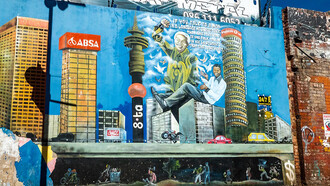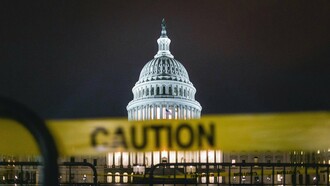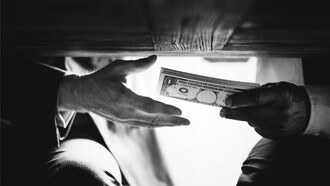As I bicycle through New York City daily, I see people walking about with their earbuds fastened to their ears and cell phone poised in front of their eyes. While walking on busy, noisy and potentially dangerous NYC streets, two senses of four are completely preoccupied. The other two are largely on pause unless there’s a physical encounter (kinesthetic) or there is a notably foul smell in the air (olfactory). In short, 50% of one’s sensory awareness is unavailable to sense the outside world, or even that there is an outside world.
It sounds funny if it weren’t so dangerous and even tragic. It gives the positive power of trances a bad name. Oblivious to one and all, many New Yorkers (and others) are moving quickly through the streets, staring at phones or listening to music on EMF-emitting blue-tooth, earbuds, even if right in front of you. The vicissitudes and dangers of daily life—drunken drivers, fast taxis, food delivery e-bikes speeding by, stressful emotions, a broken curb that was never fixed—all this, all lost to this self enclosed pedestrian, literally endangering his life and possibly others.
But he doesn’t see it that way. The world is an afterthought. In fact, it is an affront, invading his privacy. How do I know? I pass them by daily, I see it on their faces. The bubble was rippled as I ride by closely. Their non-verbal expression says “How dare you—don’t you see that I’m busy?” or there is no reaction at all. Each is concerning.
If you don’t see where you are, you can’t know how to get to where you want to go
As a cyclist, moving quicker than even the quick pedestrian, I am navigating space like a slalom skier: every square inch between people and objects is noted and has a value.
In short, the phenomenon of walking in a cyber-bubble on busy urban streets is high-risk. It’s not just bike traffic but car, truck and skate-board traffic that they walk into without any awareness of the world around them. This behavior is nothing short of irresponsible and reckless to themselves and others--and is nothing short of a miracle, as a result, that there aren’t more accidents, injuries and even fatalities.
An age-related phenomenon?
I used to think it was mainly young people, entranced by new technology, attempting to “be hip and cool” who would mainly be “bubble occupants”. It was this same phenomenon I noticed among young people when Walkmen first came on the scene: plugging in, plugging up.
But as time has gone on, I have been proven wrong: all ethnicities, all economic classes and all ages have been captured by the “Big Bubble”. The trance is everywhere.
This kind of self-preoccupied behavior also distorts social skills. So many young people, when in a line at a store or in an elevator, don’t interact with others but again, head down, are in dialogue just with their phone, typically hiding from the human standing beside them.
Psycho-sociologically, the phone is used as a prop, as a surrogate for human interaction, and a shield all at the same time. It’s become socially acceptable to “hide behind one’s phone”.
Bubbling our way into oblivion
The seriousness of consensual agreement around “bubbling” cannot be over-emphasized. If people lose the skill of speaking to each other out of some kind of learned anxiety or fear of communicating, civilization collapses. Wasn’t it said that one of the factors that led to the demise of Rome was people couldn’t communicate? Dealing with, communicating to other members of our species, which is really ultimately a matter of the greatest joy anyone can experience, as well as it being our mechanism of survival, has been dealt a techno-knock-out. Many in Gen Z (such an odd phrase, and no, not all), seem to prefer texting as social intercourse instead of talking. This won’t lead us to a promising future. This has to be addressed by parents, teachers and elders with those who are balking at a norm of social discourse that needs to be preserved.
I myself started texting long after it became a fad. I resisted it, but then it became the only way some people communicate. They won’t pick up the phone, they won’t even answer an email. With some, even many, if you don’t text, you won’t get answered.
The real problem underneath the problem
Walking blindly with a cell phone stuck to one’s hand and eyes, bumping into others, yes, these are real-world problems that I’ve addressed and need to be taken seriously. But underneath these is that people are living lives in an unconscious, sleep state. The beauty and magnificence of this gift of life is not being fully appreciated, felt and related to what it is. We’re asleep.
Life is drifting away into screens and AI, into One World governments that have no heart, nary a care about the people it has vowed to represent.
Instead of a person’s soul shining, it is shrinking. Discernment, one of our highest mental functions, is off, askew. This isn’t just about cell phones but an entire way of living that is exacerbated by cell phones and AI. And as a species, we ought to give these thoughts some serious consideration if we want to fulfill our higher human potential.
The health risks with cell phone use are very well known
The scientific literature is massive. The main issue is that the electro-magnetic fields (EMF’s) from the cell phone are permeating through the eyes into the brain, as the eyes are a visible extension of the brain. The EMFs are penetrating into the brain again through the bluetooth signals into the ear.
The person is simultaneously ensconced in their own world both psychologically, in text/emoji/video/musical content and their brains are being micro-waved.
The screen-induced trance: my life has been reduced to an emoji!
If it isn’t in the street, it is in front of the computer or the television. People are affixed and have lost touch with context, with their environment. It is harming eyesight, and I am suggesting, it is seriously harming the brain and the mind.
The result is that critical thinking is losing its place in society. People have become more docile, passive, less active and I am suggesting, more robotic and suggestible. The questioning of authority, which should always be the norm, seems to be diminishing. There may be an appropriate distrust of government and Big Tech but little action to address the propaganda coming at us from all sides.
An AI robot seems more like a relative or a friend than a piece of machinery. Robot dolls as sex partners are gaining in popularity and even showing up in movies.
Facts in mainstream media or deliberate distortions due to financial self-interest?
For instance, how many people question the veracity of stories they hear on the news? Many news departments these days are actually in the entertainment departments.
Objectively-oriented, fact-based, deep, investigative journalism has become rarified. It can be found surely, but is being cast through the lens of political bias or just slipping away like an ebbing tide.
How many people question the veracity of Presidential Administration’s announcements? It wasn’t long ago that we were told by President Bush that Iraq had a role in the 9/11 bombing of the World Trade Center and had weapons of mass destruction, that we needed a pre-emptive strike against them, with “shock and awe”.
This assertion was not partially but 100% untrue. This is not uncommon, but some lies lead to more wars or more deaths than others. This was a bad one, and actually led, I believe, to a downward spiral of America’s credibility in the world and a greater war-like and mongering mentality, from which we as a nation have never recovered. The number of lies, deceptions and omissions of fact from government agencies are so numerous for so many decades, no one could really catalog them. The ratio of truth-to-lie is abysmal, such that every official statement needs to be examined, scrutinized and fact-checked many times over.
The entranced person loses the ability to discern fact from fiction. If we have a world of people who are entranced, day by day and their brains functioning at ever-lower levels, where does this take us as a species? Add to this the upsurge and “fascination” with AI. Add to that the military industrial complex’s having mastered how to keep populations operating out of fear in their reptilian brain. We can only conclude that this is not going well for us as a collective. Maybe for the pocketbooks of a few, but certainly not for the many. Only for those who are breaking out of “The Matrix” and indeed, the good news is that more are breaking out by the day. Unlike those, however, who remain in a screen-induced trance
The life-induced trance
Life itself is both glorious, transcendental and, as Buddha himself reminded us, “rich with suffering”. Sometimes the suffering is unconscious like a low-grade fever, and sometimes it is difficult with pain screaming from the rooftops.
There just isn’t anyone, rich or poor, even largely happy, who gets out of this life without some degree of suffering, and surely doesn’t get out alive!
As a result of domestic tensions, inner or outer conflict, a trance is sometimes a way of deadening pain. The problem is that it is also a somewhat lifeless state, or at least somnambulistic. It is no way leads to a vital, adventurous, robust life.
Yet this is what we see most everywhere. So many people lead “lives of quiet desperation” so Thoreau reminds us. There’s a lack of sobriety, a wakeful quality, one that has both critical and reflective thinking available at a moment’s notice.
Imagine that a loved one needs you in an emergency—being wakeful and very conscious, anything but in a trance, is what is then most needed. A screen-induced trance state can be like taking a sedative.
Evolving out of the trance
There is hope. There is a world outside the trance, outside the Matrix. One can create a meta-position “outside” of this puzzle, this labyrinth, and see more clearly what is going on.
Once out, a sense of freedom and clarity emerge in feeling and perception. It is analogous to the brainwashing that occurs in cults and then the sense of freedom once out of the program.
We have all been programmed! But some of us are a bit more sensitive to the process and its mechanisms, giving way to a bit more leverage and possibility to emerge with our own awareness intact.
The positive power of trance
Spiritual master and teacher of dance, G.I. Gurdjieff, said over and again that “man is asleep”. Thankfully, he had ways of helping to wake people up.
Co-founder of Neuro-linguistic Programming, Richard Bandler, helped to develop what he calls a “pattern interrupt” as a way of snapping people out of a habit and to see the world anew.
Dr. Milton Erickson, on the other hand, used trance to reach to interrupt sub-conscious patterns, the effect of which then showed up as positive behavior and attitude changes in one’s daily life.
Trance and even somnambulistic, theta-based states are of unlimited value for learning, healing, re-programming. The distinction is what one wills to happen to make positive life changes and what just "happens" as one fondly gazes at one's phone.
But I am concerned, make no mistake. My bike-riding, walking and subway-ing around NYC has shown me how deep the programs are in so many. Yet, there are those throwing out life-rafts to help others sail into a more evolved level of consciousness and re-establish a sense of normalcy where love, cooperation, compassion, friendship, integrity, dignity and kindness can again, become the norm.
Nature provides an escape
When one leaves the electro-magnetic web we have weaved, of all the electronics spinning around us, when one leaves the din of the city and re-enters the wild womb of Nature, one’s breath deepens, and one’s skin drinks in the moisture. One’s eyes brighten because of vibrant colors and ears attune to the sounds. One has successfully escaped the trance of modern society which is sometimes so subtle, one doesn’t even realize that one is in it until they’re not. Nature is an excellent sanctuary.
Trance as metaphor
In a book called Re-Framing by the founders of Neuro-linguistic Programming, Richard Bandler and John Grinder, they make a statement (paraphrase): “Either everything is hypnosis, or nothing is….” Of course we know it exists as the trance-state exists. It’s more of a question of whether we are using it or it is using us.
A hypnotic, trance state is superb for de-programming and reprogramming as discussed, and it can also be a profoundly restful state. But as people are walking around in a state of hypnosis, they are also walking around in a state of zombie-like suggestibility, and in a world replete with commercial interests virtually everywhere, this could become seriously problematic.
Trance as transcendent
There are consciously induced trances which occur through meditation, the use of plant medicine, through hypnosis, that, ironically enough, have among the most enlightening effects on consciousness. As said above, the issue at hand isn’t the trance itself but is it actively consciously induced or passively, unconsciously induced? This distinction is critical and not casual.
A parallel can be made between a trance state and Samadhi, which is a consciously sought state, distinct from a state of some grogginess as one lifts one head up from staring at a screen for an hour. These are entirely different types of trance.
Waking up is hard to do…
So our most human challenge, along with loving each other with all our hearts, being kind to each other to the bone, being as authentic yet diplomatic as humanly possible, is to remain conscious, clear, mindful and wakeful. We can use and enjoy our devices and screens, with the proviso that we do so with moderation, mindfully and with clear intent.
One of the challenges in waking up is to see just how asleep we have been. We see how naïve perhaps we’ve been about how the human world works. Who controls it, who calls the shots?
How different is it from what we’ve been told it is. Have a class of people getting away, literally, with murder, involved, a la Bernays, programming us to consume things we really don’t need, to hold materialist values and habits that might not really be “us? Or to vote in ways that don’t feel resonant with who we are due to media stories and advertising?
Some people wake up in their 40’s or 50’s when half their life may be gone, and they have trouble identifying or aligning with a sense of deeper meaning, purpose, heart or soul.
Attention can break through a trance & wake us up
Some say that our greatest gift to others and to ourselves is our attention. Giving our attention is a form of giving love. When our attention is incoherent, hither and thither, jumping from one text to another, in some way we are jeopardizing our humanity and our safety.
When we have control over our coherent attention, we can be fully engaged in our humanity and really contribute to waking up our brothers and our sisters.















